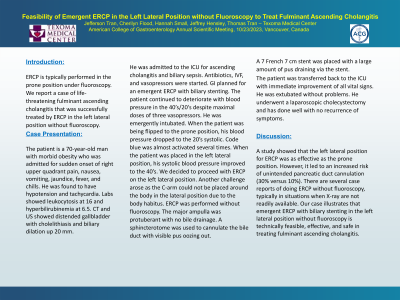Monday Poster Session
Category: Biliary/Pancreas
P1511 - Feasibility of Emergent ERCP in the Left Lateral Position Without Fluoroscopy to Treat Fulminant Ascending Cholangitis
Monday, October 23, 2023
10:30 AM - 4:15 PM PT
Location: Exhibit Hall

Has Audio
- JT
Jefferson Tran, MD
TMC
Denison, TX
Presenting Author(s)
Jefferson Tran, , Cherilyn Flood, RN, Hannah Small, RN, Jeffrey Hensley, RN, Thomas Tran, MD
TMC, Denison, TX
Introduction: ERCP is typically performed in the prone position under fluoroscopy to facilitate selective bile duct cannulation and visualize radiologic images of the pancreaticobiliary anatomy. We report a case of life-threatening fulminant ascending cholangitis that was successfully treated by ERCP in the left lateral position without fluoroscopy.
Case Description/Methods: The patient is a 70-year-old man with morbid obesity who was admitted for sudden onset of right upper quadrant pain, nausea, vomiting, jaundice, fever, and chills. He was found to have hypotension and tachycardia. Labs showed leukocytosis at 16 and hyperbilirubinemia at 6.5. CT and US showed distended gallbladder with cholelithiasis and biliary dilation up 20 mm. He was admitted to the ICU for ascending cholangitis and biliary sepsis. Antibiotics, IVF, and vasopressors were started. GI planned for an emergent ERCP with biliary stenting. The patient continued to deteriorate with blood pressure in the 40’s/20's despite maximal doses of three vasopressors. He was emergently intubated. When the patient was being flipped to the prone position, his blood pressure dropped to the 20’s systolic. Code blue was almost activated several times. When the patient was placed in the left lateral position, his systolic blood pressure improved to the 40’s. We decided to proceed with ERCP on the left lateral position. Another challenge arose as the C-arm could not be placed around the body in the lateral position due to the body habitus. ERCP was performed without fluoroscopy. The major ampulla was protuberant with no bile drainage. A sphincterotome was used to cannulate the bile duct with visible pus oozing out. A 7 French 7 cm stent was placed with a large amount of pus draining via the stent. The patient was transferred back to the ICU with immediate improvement of all vital signs. He was extubated without problems. He underwent a laparoscopic cholecystectomy and has done well with no recurrence of symptoms.
Discussion: A study showed that the left lateral position for ERCP was as effective as the prone position. However, it led to an increased risk of unintended pancreatic duct cannulation (30% versus 10%). There are several case reports of doing ERCP without fluoroscopy, typically in situations when X-ray are not readily available. Our case illustrates that emergent ERCP with biliary stenting in the left lateral position without fluoroscopy is technically feasible, effective, and safe in treating fulminant ascending cholangitis.
Disclosures:
Jefferson Tran, , Cherilyn Flood, RN, Hannah Small, RN, Jeffrey Hensley, RN, Thomas Tran, MD. P1511 - Feasibility of Emergent ERCP in the Left Lateral Position Without Fluoroscopy to Treat Fulminant Ascending Cholangitis, ACG 2023 Annual Scientific Meeting Abstracts. Vancouver, BC, Canada: American College of Gastroenterology.
TMC, Denison, TX
Introduction: ERCP is typically performed in the prone position under fluoroscopy to facilitate selective bile duct cannulation and visualize radiologic images of the pancreaticobiliary anatomy. We report a case of life-threatening fulminant ascending cholangitis that was successfully treated by ERCP in the left lateral position without fluoroscopy.
Case Description/Methods: The patient is a 70-year-old man with morbid obesity who was admitted for sudden onset of right upper quadrant pain, nausea, vomiting, jaundice, fever, and chills. He was found to have hypotension and tachycardia. Labs showed leukocytosis at 16 and hyperbilirubinemia at 6.5. CT and US showed distended gallbladder with cholelithiasis and biliary dilation up 20 mm. He was admitted to the ICU for ascending cholangitis and biliary sepsis. Antibiotics, IVF, and vasopressors were started. GI planned for an emergent ERCP with biliary stenting. The patient continued to deteriorate with blood pressure in the 40’s/20's despite maximal doses of three vasopressors. He was emergently intubated. When the patient was being flipped to the prone position, his blood pressure dropped to the 20’s systolic. Code blue was almost activated several times. When the patient was placed in the left lateral position, his systolic blood pressure improved to the 40’s. We decided to proceed with ERCP on the left lateral position. Another challenge arose as the C-arm could not be placed around the body in the lateral position due to the body habitus. ERCP was performed without fluoroscopy. The major ampulla was protuberant with no bile drainage. A sphincterotome was used to cannulate the bile duct with visible pus oozing out. A 7 French 7 cm stent was placed with a large amount of pus draining via the stent. The patient was transferred back to the ICU with immediate improvement of all vital signs. He was extubated without problems. He underwent a laparoscopic cholecystectomy and has done well with no recurrence of symptoms.
Discussion: A study showed that the left lateral position for ERCP was as effective as the prone position. However, it led to an increased risk of unintended pancreatic duct cannulation (30% versus 10%). There are several case reports of doing ERCP without fluoroscopy, typically in situations when X-ray are not readily available. Our case illustrates that emergent ERCP with biliary stenting in the left lateral position without fluoroscopy is technically feasible, effective, and safe in treating fulminant ascending cholangitis.
Disclosures:
Jefferson Tran indicated no relevant financial relationships.
Cherilyn Flood indicated no relevant financial relationships.
Hannah Small indicated no relevant financial relationships.
Jeffrey Hensley indicated no relevant financial relationships.
Thomas Tran indicated no relevant financial relationships.
Jefferson Tran, , Cherilyn Flood, RN, Hannah Small, RN, Jeffrey Hensley, RN, Thomas Tran, MD. P1511 - Feasibility of Emergent ERCP in the Left Lateral Position Without Fluoroscopy to Treat Fulminant Ascending Cholangitis, ACG 2023 Annual Scientific Meeting Abstracts. Vancouver, BC, Canada: American College of Gastroenterology.
